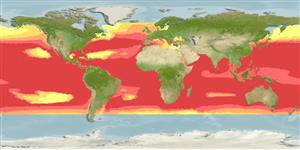Environment: milieu / climate zone / depth range / distribution range
ນິເວດວິທະຍາ
ສັດທະເລ; ປາທີ່ມີການເຄື່ອນຍ້າຍໃນສະເພາະມາະຫາສະມຸດ; ລະດັບຄວາມເລິກ 0 - 260 m (Ref. 9340), usually 0 - ? m (Ref. 55287). Tropical; 15°C - 30°C (Ref. 168); 63°N - 47°S, 180°W - 180°E
Cosmopolitan in tropical and warm-temperate waters. Not found in the Black Sea. Highly migratory species,
Length at first maturity / ຂະໜາດ / ນ້ຳໜັກ / Age
Maturity: Lm 41.3, range 40 - 45 cm
Max length : 110 cm FL ຕົວຜູ້/ບໍ່ມີເພດ; (Ref. 89423); common length : 80.0 cm FL ຕົວຜູ້/ບໍ່ມີເພດ; (Ref. 168); ນ້ຳໜັກສູງສຸດທີ່ເຄຍຈັດພີມມາ: 34.5 kg (Ref. 168); ອາຍຸສູງສຸດທີ່ເຄຍລາຍງານມາ: 12 ປີ (Ref. 168)
ຄີ (ໜາມ)ແຂງຢູ່ຫຼັງປາ (ທັງໝົດ): 14 - 16; ຄີຫຼັງຂອງປາ (ຄີອ່ອນ) (ທັງໝົດ): 14-15; ຄີ(ໜາມ) ແຂງຢູ່ຄີກົ້ນປາ
ກຸ່ມປາກະດູກແຂງ
ຄວາມຖີ່ຂອງກຸ່ມຖ່າຍທອດພັນ
ປາທີ່ມີການເຄື່ອນຍ້າຍຈາກທະເລໄປຫານ້ຳຈືດ ແລະນ້ຳຈືດຫາທະເລ
ປາທີ່ມີການເຄື່ອນຍ້າຍຈາກທະເລແລະໄປໄຂ່ຢູ່ນ້ຳຈືດ
ຄີກົ້ນຂອງປາ
ສັດທີ່ມີກະດູກສັນຫັຼງ
ການຖ່າຍທອດທາງກຳມະພັນຈາກພໍ່ແມ່ຫາລູກ 0; ຄີກົ້ນຂອງປາ: 14 - 15; ສັດທີ່ມີກະດູກສັນຫຼັງ: 41. This species is distinguished by the following characters: body fusiform, elongate and rounded; teeth small and conical, in a single series; gill rakers on first gill arch numerous, 53-63; D1 XIV-XVI, dorsal fins separated by a small interspace (not larger than eye), the second followed by 7-9 finlets; anal fin followed by 7-8 finlets; pectoral fins short, with 26-27 rays; 2 flaps (interpelvic process) between pelvic fins; body scaleless except for corselet and lateral line; a strong keel on each side of caudal-fin base between 2 smaller keels. Colour of back dark purplish blue, lower sides and belly silvery, with 4-6 very conspicuous longitudinal dark bands which in live specimens may appear as discontinuous lines of dark blotches (Ref. 9684).
Found in offshore waters; larvae restricted to waters with surface temperatures of 15°C to 30°C (Ref. 6390). Exhibit a strong tendency to school in surface waters with birds, drifting objects, sharks, whales and may show a characteristic behavior like jumping, feeding, foaming, etc. Feed on fishes, crustaceans, cephalopods and mollusks; cannibalism is common. Spawn throughout the year in the tropics, eggs released in several portions (Ref. 35388). Eggs and larvae are pelagic (Ref. 6769). Preyed upon by large pelagic fishes (Ref. 6885). Also taken by trolling on light tackle using plugs, spoons, feathers, or strip bait (Ref. 9684). Marketed fresh, frozen or canned (Ref. 9340, 9684 ); also dried-salted and smoked (Ref. 9987).
In tropical waters, reproductively active female skipjack tuna spawn almost daily.
Collette, B.B. and C.E. Nauen, 1983. FAO Species Catalogue. Vol. 2. Scombrids of the world. An annotated and illustrated catalogue of tunas, mackerels, bonitos and related species known to date. Rome: FAO. FAO Fish. Synop. 125(2):137 p. (Ref. 168)
IUCN Red List Status (Ref. 130435)
Threat to humans
Reports of ciguatera poisoning (Ref. 4690)
Human uses
ການປະມົງ: ທີ່ມີການຄ້າສູງ; ຊະນິດປາທີ່ຖືກນຳໃຊ້ເຂົ້າໃນການຫາເພື່ອເປັນເກມກິລາ: ແມ່ນ
ເຄື່ອງມື
Special reports
Download XML
ແຫຼ່ງອີນເຕີເນັດ
Estimates based on models
Preferred temperature (Ref.
123201): 13.3 - 29, mean 26.2 °C (based on 8934 cells).
Phylogenetic diversity index (Ref.
82804): PD
50 = 1.0000 [Uniqueness, from 0.5 = low to 2.0 = high].
Bayesian length-weight: a=0.01072 (0.00955 - 0.01202), b=3.10 (3.07 - 3.13), in cm total length, based on LWR estimates for this species (Ref.
93245).
ຊັ້ນເຂດຮ້ອນ (Ref.
69278): 4.4 ±0.5 se; based on diet studies.
Generation time: 2.1 (1.8 - 2.4) years. Estimated as median ln(3)/K based on 57
growth studies.
ຄວາມຢືດຢຸ່ນ (Ref.
120179): ຂະໜາດກາງ, ປະຊາກອນຕຳ່ສຸດທີ່ໃຊ້ເວລາສອງເທົ່າ 1.4 - 4.4 ປີ (K=0.3-0.5; tm=2-3; tmax=12; Fec=61,516).
Prior r = 0.57, 95% CL = 0.37 - 0.85, Based on 7 stock assessments.
Fishing Vulnerability (Ref.
59153): Moderate vulnerability (38 of 100).
Climate Vulnerability (Ref.
125649): Moderate vulnerability (41 of 100).
Nutrients (Ref.
124155): Calcium = 155 [39, 307] mg/100g; Iron = 2.27 [0.81, 7.03] mg/100g; Protein = 22.3 [20.8, 23.6] %; Omega3 = 0.45 [0.22, 1.05] g/100g; Selenium = 87.4 [31.2, 237.6] μg/100g; VitaminA = 6.64 [1.25, 40.76] μg/100g; Zinc = 1.54 [0.37, 3.23] mg/100g (wet weight); based on
nutrient studies.
